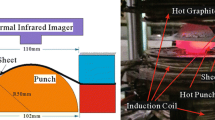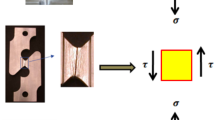Abstract
Punching is an important process of the production for ultra-high-strength steel automobile components. By selecting the appropriate punching parameters, the punching quality can be effectively improved and the punching force can be reduced. In this study, several typical fracture damage models applicable to the punching process of high strength steel were compared, where the critical damage values were calculated through an iterative predictor–corrector approach. Meanwhile, the effects of punching parameters on maximum punching force (MPF) and punched face quality for hot stamped ultra-high strength steel Usibor1500P were investigated experimentally. The results show that the Oyane damage model is the most suitable one in simulating the punching process of Usibor1500P, which can better predict the punched profile features and the variation of punching force within one stroke. The increase in die clearance decreases the MPF, while the plate thickness, punch diameter and punch corner radius increase the MPF. The change of the punch corner radius has the most significant effect on the improvement of the punched face quality.















Similar content being viewed by others
Data availability
All data generated or analyzed during this study are included in this article.
References
Tisza M, Czinege I (2018) Comparative study of the application of steels and aluminium in lightweight production of automotive parts. Int J Light Mater Manuf 1:229–238. https://doi.org/10.1016/j.ijlmm.2018.09.001
Taylor T, Clough A (2018) Critical review of automotive hot-stamped sheet steel from an industrial perspective. Mater Sci Technol 34:809–861. https://doi.org/10.1080/02670836.2018.1425239
Levy BS, Van Tyne CJ (2011) Review of the shearing process for sheet steels and its effect on sheared-edge stretching. J Mater Eng Perform 21:1205–1213. https://doi.org/10.1007/s11665-011-9997-x
Shivpuri R, Singh S, Agarwal K, Liu C (2011) Energy release rate based approach for the wear of punches in precision blanking of high strength steel. CIRP Ann 60:307–310. https://doi.org/10.1016/j.cirp.2011.03.139
Sontamino A, Nitnara C (2022) A fuzzy logic base for selecting optimal clearance of die-cutting process. In: Batako A, Burduk A, Karyono K, Chen X, Wyczółkowski R (eds) Advances in manufacturing processes, intelligent methods and systems in production engineering. Springer International Publishing, Cham, 157–168. https://doi.org/10.1007/978-3-030-90532-3_13
Chang Y, Han S, Li X, Wang C, Zheng G, Dong H (2018) Effect of shearing clearance on formability of sheared edge of the third-generation automotive medium-Mn steel with metastable austenite. J Mater Process Technol 259:216–227. https://doi.org/10.1016/j.jmatprotec.2018.04.038
Mori K, Abe Y, Kidoma Y, Kadarno P (2013) Slight clearance punching of ultra-high strength steel sheets using punch having small round edge. Int J Mach Tools Manuf 65:41–46. https://doi.org/10.1016/j.ijmachtools.2012.09.005
Bai Y, Wierzbicki T (2008) A new model of metal plasticity and fracture with pressure and Lode dependence. Int J Plast 24:1071–1096. https://doi.org/10.1016/j.ijplas.2007.09.004
Yu X, Chen J, Zhang B (2020) Numerical simulation on edge crack of advanced high-strength steel considering blanking induced damage. J Mater Eng Perform 29:8286–8293. https://doi.org/10.1007/s11665-020-05260-4
Hu Q, Li X, Han X, Chen J (2017) A new shear and tension based ductile fracture criterion: Modeling and validation. Eur J Mech A Solids 66:370–386. https://doi.org/10.1016/j.euromechsol.2017.08.005
Li D, Wu H, Zhan X, Chang Z, Chen J (2022) A new ductile fracture model for edge cracking prediction of ultra-high strength steel considering damage accumulation in blanking process. J Mater Eng Perform 31:6880–6890. https://doi.org/10.1007/s11665-022-06718-3
He J, Wang Z, Li S, Dong L, Cao X, Zhang W (2018) Optimum clearance determination in blanking coarse-grained non-oriented electrical steel sheets: experiment and simulation. IntJ Mater Form 12:575–586. https://doi.org/10.1007/s12289-018-1435-2
Han X, Yang K, Ding Y, Tan S, Chen J (2016) Numerical and experimental investigations on mechanical trimming process for hot stamped ultra-high strength parts. J Mater Process Technol 234:158–168. https://doi.org/10.1016/j.jmatprotec.2016.03.025
Qian L, Ji W, Sun C, Fang G, Lian J (2021) Prediction of edge fracture during hole-flanging of advanced high-strength steel considering blanking pre-damage. Eng Fract Mech 248:107721. https://doi.org/10.1016/j.engfracmech.2021.107721
Hambli R, Potiron A (2000) Finite element modeling of sheet-metal blanking operations with experimental verification. J Mater Process Technol 102:257–265. https://doi.org/10.1016/S0924-0136(00)00496-9
Brokken D, Brekelmans WAM, Baaijens FPT (1998) Numerical modelling of the metal blanking process. J Mater Process Technol 83:192–199. https://doi.org/10.1016/S0924-0136(98)00062-4
Bai Y, Wierzbicki T (2015) A comparative study of three groups of ductile fracture loci in the 3D space. Eng Fract Mech 135:147–167. https://doi.org/10.1016/j.engfracmech.2014.12.023
Oyane M, Sato T, Okimoto K, Shima S (1980) Criteria for ductile fracture and their applications. J Mech Work Technol 4:65–81. https://doi.org/10.1016/0378-3804(80)90006-6
Rice JR, Tracey DM (1969) On the ductile enlargement of voids in triaxial stress fields∗. J Mech Phys Solids 17:201–217. https://doi.org/10.1016/0022-5096(69)90033-7
Bai Y, Wierzbicki T (2009) Application of extended Mohr-Coulomb criterion to ductile fracture. Int J Fract 161:1–20. https://doi.org/10.1007/s10704-009-9422-8
Cockcroft MG, Latham DJ (1968) Ductility and the workability of metals. J Inst Met 96:33–39
Freudenthal AM (1950) The inelastic behavior of engineering materials and structures. John Wiley & Sons, New York
Wang C, Chen J, Xia C, Ren F, Chen J (2014) A new method to calculate threshold values of ductile fracture criteria for advanced high-strength sheet blanking. J Mater Eng Perform 23:1296–1306. https://doi.org/10.1007/s11665-013-0861-z
Mori K-i, Nakamura N, Abe Y, Uehara Y (2021) Generation mechanism of residual stress at press-blanked and laser-blanking edges of 1.5 GPa ultra-high strength steel sheet. J Manuf Process 68:435–444. https://doi.org/10.1016/j.jmapro.2021.05.047
Funding
This work was supported by the National Key Research and Development Program of China (No. 2022YFE0196600), the National Natural Science Foundation of China (No. 52175349), and the Natural Science Foundation of Shanghai (No. 21ZR1429600).
Author information
Authors and Affiliations
Contributions
Chendong Yang: methodology, formal analysis, writing—original draft. Jincan Wei: methodology, investigation, writing—reviewing and editing. Zhen Chen: data curation, resources. Shaofei Qu: project administration. Xianhong Han: resources, writing—reviewing and editing, supervision, funding acquisition. All authors have read and agreed to the published version of the manuscript.
Corresponding author
Ethics declarations
Ethics approval
Not applicable.
Consent to participate
Not applicable.
Consent for publication
The authors consent that the work entitled as “Study of fracture damage criteria and influence of process parameters on punching of hot stamped ultra-high strength steel” for possible publication in International Journal of Advanced Manufacturing Technology.
Competing interests
The authors declare no competing interests.
Additional information
Publisher's note
Springer Nature remains neutral with regard to jurisdictional claims in published maps and institutional affiliations.
Rights and permissions
Springer Nature or its licensor (e.g. a society or other partner) holds exclusive rights to this article under a publishing agreement with the author(s) or other rightsholder(s); author self-archiving of the accepted manuscript version of this article is solely governed by the terms of such publishing agreement and applicable law.
About this article
Cite this article
Yang, C., Wei, J., Chen, Z. et al. Study of fracture damage criteria and influence of process parameters on punching of hot stamped ultra-high strength steel. Int J Adv Manuf Technol 128, 1493–1504 (2023). https://doi.org/10.1007/s00170-023-11980-3
Received:
Accepted:
Published:
Issue Date:
DOI: https://doi.org/10.1007/s00170-023-11980-3




